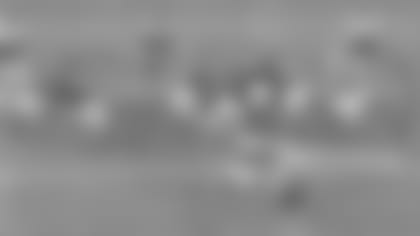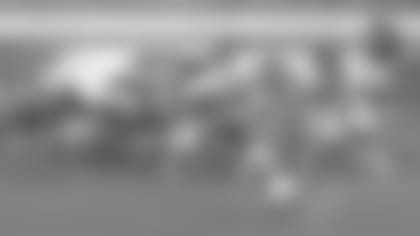After the Dallas Cowboys eked out a victory from the jaws of utter defeat on Sunday afternoon, the word "meaningless" was being thrown around a lot in Philadelphia leading up to the Eagles' rout of the Chicago Bears.
"The game against Chicago is meaningless," fans said.
"Sit the starters Chip, there's nothing to gain here," they added.
But Chip Kelly proved them wrong. Sunday's win had real meaning. That win means that an Eagles win (or tie, as Kelly reminded us after the game) secures the NFC East for the first time in three years. That win means that this team has officially moved on from the disappointment in Minnesota. That win means that the Eagles head to Dallas riding the momentum of holding one of the most feared offenses in football to nearly nothing. That win means if the Eagles beat Dallas on Sunday, they'll be one of the hottest teams heading into the playoffs, and a squad that no one will want to face with the season on the line.
Let's take a look at what led to the victory. As you can imagine, there's a lot to break down ...

The success on offense started with the very first play. It's first-and-10, and the Eagles come out in 13 personnel. This isn't a grouping the Eagles have used much this season, but it is something that fans and media pondered over the spring and summer after the additions of James Casey and Zach Ertz and the return of Brent Celek.
There has been an ebb and flow in regards to the "use" of the tight end position throughout the season, but Sunday's game was what many imagined the offense would look like back in June. Here it is on the first play - one running back, one receiver (DeSean Jackson) and three tight ends. At the bottom of the screen, Ertz and Casey are lined up wide. Celek is lined up on the line of scrimmage at the top of the screen.
I explained how multiple tight end sets can help an offense before the matchup against Detroit. To sum it up, if you have multiple tight ends that you have faith in both the run and pass game with, there are a lot of options for a playcaller. You can go out with two or three of these players on the field and, depending on how the defense is deployed, spread them out or go with a heavy formation and run right at them. This is why 12 and 13 personnel are extremely tough groupings to defend. Do you expect run or pass? Well, I crunched the numbers, and in Sunday's win, the Eagles came out in multiple tight end sets 20 times in the first half. Of those 20 plays, 12 were runs (6.0 yards per carry) and 8 were passes (8.4 yards per catch). That's a near 50-50 split. When you're unpredictable out of those sets, your offense becomes very tough to game plan for, especially when you throw in read option elements.

This is a play the Eagles ran multiple times against the Bears out of this exact grouping and formation. Before the snap, DeSean Jackson is brought in motion from right to left, running a bubble to the bottom of the screen with two lead blockers in front of him (Ertz and Casey). Meanwhile, Jason Kelce and Todd Herremans will pull, and serve as lead blockers on a perimeter run for LeSean McCoy to the right. It will be up to Nick Foles to read the defense and decide who gets the ball, McCoy or Jackson.

Let's look at the end zone angle. The ball is snapped, and Chicago's cornerback (Tim Jennings, blue arrow) runs with Jackson's motion across the formation. That's one less defender to the right side.

Let's fast forward to the mesh point (where the possible handoff between Foles and McCoy takes place). Foles appears to be reading defensive end Julius Peppers (circled) on this play. He was unblocked. The blue arrow is coming from rookie linebacker Jon Bostic, a player we did a scouting report on last week. Bostic misreads this play, as he is drawn towards the left and Jackson's bubble screen-action. He takes himself out of the play.

Foles hands this ball off to McCoy, and he's got a series of great blocks. Kelce and Herremans both do a great job getting a hat on a hat, taking their men out of the play. Celek seals off the defensive end. Jason Peters (not having to block Bostic since he completely bit on the fake) peels back to take a pursuit player from the back side. With Jennings, Bostic and Peppers (who hesitated at the snap thanks to the fake) out of the play, there's plenty of room for McCoy to go for 19 yards on the first play of the game and set the tone for the rest of the night.

Later in the first quarter, it's already 7-0, and the Eagles are knocking on the door. It's first-and-10 at the Chicago 12-yard line, and we see the same play.

Foles will have the bubble option to the left, and the sweep to the right with Kelce and Herremans blocking for McCoy on the perimeter. How will Chicago defend it?

Last time, the Bears were in man coverage, as we saw cornerback Tim Jennings follow Jackson across the formation. This time, it's a zone look, as we see Jennings stop and point out Jackson, calling for one of his teammates to pick him up.

That doesn't happen, as Foles hits Jackson in the flat. Ertz and Casey do a great job out in front, blocking outside-in and giving Jackson room to slip this to the sideline and into the end zone. Unfortunately, Jackson chooses to cut this inside and is tackled inside the 5-yard line. Still great design, and great execution from Foles, getting the ball into the right person's hands on this play.
Let's take a look at another big run play, this time out of 12 personnel with just two tight ends.

It's first-and-10, and you have two tight ends on the line of scrimmage, Casey on the left and Celek on the right.

This is just a simple inside zone run from the Eagles. Whether or not there was a called "read" for Nick Foles is irrelevant, because the Bears defend as if there is (as they should). Lance Briggs will "scrape" to defend the keeper from Foles, and Bostic will play the run inside. They appear to be in position to make this play.

However, Bostic, again, misreads this play. His eyes stay on Foles, and he takes himself out of the action, taking two steps inside and allowing Evan Mathis to get in position to seal him off. I would be remiss if I didn't mention Peters, who drives Peppers 5 yards off the ball on this play.
Peters dominated Peppers throughout the game on Sunday night, one of his best performances of the season. McCoy would take this third quarter run for a gain of 17 and a first down.
Inside zone was prevalent on Sunday, but the real thorn in the side of the Chicago Bears' front seven was the split zone run.

Again, a two tight end set. This time we see Celek and Casey lined up on the same side of the formation. Casey will come back across the formation to block the backside defensive end, Shea McLellin.

The idea, here, is that the line creates a wall, and Casey's block will help create a crease for LeSean McCoy to run through. As it did most of the night, including on [Chris Polk's touchdown run, this works to perfection, and McCoy plunges through for his first touchdown of the night.

The Eagles offense stung the Bears with the split zone run repeatedly throughout the night, and they used that play to benefit the passing game as well.

This play will look similar, with Casey coming across the line of scrimmage to block the backside defensive end as the offensive line sells inside zone-action to the left.

This will actually be a pass play, however, as the Eagles will go to a concept they hit on a few different times from multiple looks, the three-level stretch. Riley Cooper will be taking the top off the defense with a deep post route. Celek will be running an intermediate in-breaking route, and McCoy will leak into the flat. Foles appears to work from deep to short on this play, with his first read being Cooper down the field, then Celek and McCoy lastly as a check-down.

Celek runs a great route here, creating separation from safety Major Wright at the top of his stem. Above, he is sticking his foot in the ground with Wright a half-step behind him.

Look at the separation Celek gets at the top of his route, as Foles delivers the ball for a 24-yard gain on first down.
Foles was very, very impressive against the Bears, and it started from the first drive of the game.

It's third-and-goal from the 5-yard line, and the Eagles come out, again, in the 13-personnel grouping we talked about earlier. Except this time, instead of spreading the field, this is a "heavy" formation with two tight ends to the right, and "two" to the left, with the second being Cooper in a three-point stance.

After play-action off an inside zone-fake, Foles will roll right and have his choice of two "hi-low" concepts. Per Kelly, Foles will work from right to left.

With Foles and the receivers flowing to the right, the inside zone-action gets the defense flowing left. After realizing the fake, they all have to retrace, and get in position for their responsibilities in coverage. Chances are that someone will get lost in the mess.

That player was Bostic, who took himself so far out of the play that he will be unable to keep up with Cooper (who will be a mismatch for the fellow former Florida Gator in a normal situation, much less when Bostic is playing from behind).

Foles calmly rolls right, sees his first two options are taken away (circled), and sees Cooper finding a soft spot in the coverage, as he hits him in the back of the end zone to make it 7-0, good guys.

Last week, the Eagles ran a new wrinkle of a play that had gained a lot of yards for them in recent games, and they went back to that wrinkle on Sunday as it resulted on Celek's 10-yard touchdown grab.

We've seen this drawing before. It's the "mesh" concept using underneath crossing routes to "pick" defenders off to create space for open receivers underneath, paired with the wheel route out of the backfield. The Eagles have run this repeatedly, and it's one of their go-to routes to defeat man coverage (in fact, we first saw this in the first meeting against Dallas). So if the Eagles run it so often, teams should be prepared to stop it, right? Well, the Eagles have an answer for that.

Notice, in the circle, linebacker Lance Briggs, sitting on the crosser underneath. He is fully expecting the mesh concept that has been used so efficiently. But instead of running across the field, where Briggs thinks he's going, Celek sticks his foot in the ground and pivots back outside towards the sideline. Not only does Briggs lose leverage in his defense of Celek on this play, but he will have to fight through the route of Zach Ertz (coming from the right of the screen). Celek has more than enough space to run into, Foles gets him the ball and he runs it in for an easy six points.

Foles was incredibly productive against the Bears, completing a team-record 84 percent of his passes to go along with 230 yards and a pair of touchdowns. As is usually the case, his high level of production can be attributed to not only great scheme, but a great understanding of the nuances of the quarterback position. Some innate traits that he showed during his time at Arizona and during his brief time here in Philadelphia were put on display against Chicago.

It's first-and-10 from the 39-yard line, and again the Eagles attack the Bears with a three-level-stretch.

At the top of his drop, Foles sees that all of his initial options are covered up. This play will take some improvisation from the second-year quarterback.

Foles calmly rolls to his right, and his eyes never drop. He never looks at the pressure, instead feeling it, moving out of the pocket and keeping his eyes downfield he finds the rookie Ertz for a 27-yard gain. This was a trait we saw from Foles a lot in his rookie year, and it's one of his most impressive attributes. The ability to stay calm, break the pocket and keep your eyes downfield is a great quality to have as a quarterback.

Later in the game, and it's another three-level stretch from the Eagles ...

It's first-and-10. Cooper is at the top of the screen running a vertical route down the field, with Jason Avant running a 10-yard out and Jackson running a quick bubble to the flat.

Foles, knowing that the outside corner will be taken out of the picture by Cooper's vertical route, throws a pump fake to Jackson in the flat. This causes that underneath defender (safety Chris Conte) to crash down on the bubble.

After moving Conte out of the way with the pump fake, Foles throws it right into the vacated area, into the waiting arms of Avant, who makes a defender miss and goes for 17 yards and a first down. Manipulating second-level defenders with his eyes and pump fakes has been a strength of Foles' all year long, and it's something that will always be one of his best qualities as a passer.

Let's move over to the defense, where even the most optimistic of prognosticators outside the NovaCare Complex last week couldn't have imagined a scenario where they held the explosive Bears passing game to just 11 points on the night.
Up front, defensive ends Fletcher Cox and Cedric Thornton were outstanding. Mychal Kendricks had a great game against the run and as a blitzer. Trent Cole posted a hat trick with three sacks. And the secondary? They limited Alshon Jeffery and Brandon Marshall to just 10 catches for 112 yards and a touchdown between the pair, much of which came with the outcome already in hand. They scored their first defensive touchdown of the season, and a safety on top of it.
Let's take a look at some of the things that led to their success.
The Eagles did a great job breaking down the Chicago protection schemes all night long, leaving Bears linemen blocking ghosts while rushers came free to hit quarterback Jay Cutler. This play was a prime example, Trent Cole's first sack of the night.

It's third-and-3, and the Eagles are showing double A-gap pressure with middle linebackers DeMeco Ryans and Kendricks lined up directly over the center. As many as six players could be coming after the quarterback on this play, as far as Chicago knows, and they need to account for them.

With five linemen and Matt Forte, the numbers are equal, and the Bears should have enough bodies to account for Eagles rushers. Forte will have to come across the formation to block Cole, a physical mismatch, but with him being the farthest from the quarterback, that's a risk the Bears are willing to take.

The risk didn't pay off. Why? Because the Eagles don't bring six, they actually bring four. Ryans and Kendricks drop back into coverage, and four Chicago linemen are now blocking two Eagles defenders. Cole is one-on-one with the back, Forte, and this is something the Eagles exploit.

Cole defeats Forte's block, and collapses on Cutler for his first of three sacks on the night.

It's a bit later in the game, late in the third quarter, and it's first-and-10 for the Bears. The Eagles show a similar looking pressure, with Ryans and Kendricks lined up in the A-gaps.

This time, the Bears choose to block Ryans with the running back. The center will block Kendricks, who at this point had already hit Cutler multiple times on blitzes.

This time, Kendricks drops, but Ryans comes. This is a five-man pressure, and Ryans is one-on-one with running back Matt Forte. Chicago's center, Roberto Garza, isn't blocking anyone with Kendricks dropping back in coverage ("blocking ghosts").

The Eagles have a tackle-end stunt going up front, with Cox looping over top of Cole, who is slanting inside. Cole runs right off of Ryans left hip, and with the left tackle Jermon Bushrod getting caught up in the mess of bodies, Cole comes free to Cutler for the sack. Notice, again, the center not blocking a soul in the middle of the frame.

Before we move on, let's look at the coverage on the back end. Where did Kendricks drop? He helped Brandon Boykin cover Brandon Marshall, of course! This is something we've seen the Eagles do often against star receivers, and that was no different on Sunday, as No. 95 was everywhere on the field. The rest of the coverage down the field was tight, forcing Cutler to hold the football longer than he would've wanted to, and allowing Cole to come in for the sack. This is defensive football.

Cole wasn't the only player to come up with a big play on defensive, let's look at what led to Boykin's pick six in the fourth quarter.

First, let's look at a play from early in the second quarter. The Eagles are playing Cover 3, with three deep (yellow arrows) and four underneath (blue arrow) defenders.

One of those underneath defenders is Boykin, who is defending an out route from Jeffery. Cutler releases the ball, but Boykin is unable to jump the route, and gives up a 13-yard catch.

Later in the game, with just over eight minutes left, the Eagles are once again in Cover 3. And Boykin, again, will be an underneath defender at the bottom of the screen.

Boykin is forced to defend the out-breaking route from Chicago receiver Earl Bennett, but this time is able to jump it. Boykin makes a great play on the ball, comes up with the interception and returns it 54 yards for the first defensive touchdown of the season for the Eagles. This was a great play from the young corner, especially considering the adjustment after allowing a completion on a similar play earlier in the game.

Fran Duffy is the producer of the Eagles Game Plan show which can be seen on 6abc Sundays at 11:30 AM. Prior to joining the Eagles in 2011, Duffy was the Head Video Coordinator for the Temple University Football team under former head coach Al Golden. In that role, he spent thousands of hours shooting, logging, and assisting with the breakdown of the All-22 film from the team's games, practices, and opponents.















